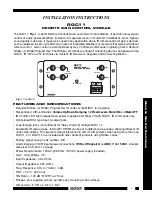
SARA-R4 series - System Integration Manual
UBX-16029218 - R06
System description
Page 17 of 102
1.5.1.2
VCC current consumption in connected-mode
During an LTE Category M1 connection, the SARA-R4 series modules transmit and receive in half duplex mode.
The current consumption depends on output RF power, which is always regulated by the network (the current
base station) sending power control commands to the module. These power control commands are logically
divided into a slot of 0.5 ms (time length of one Resource Block), thus the rate of power change can reach a
maximum rate of 2 kHz.
Figure 3 shows an example of SARA-R4 modules’ current consumption profile versus time in connected-mode:
transmission is enabled for one sub-frame (1 ms) according to LTE Category M1 half duplex connected-mode.
Detailed current consumption values can be found in
SARA-R4 series
Data Sheet
Time
[ms]
Current [mA]
Current consumption value
depends on TX power and
actual antenna load
1 Slot
1 Resource Block
(0.5 ms)
1 LTE Radio Frame
(10 ms)
0
300
200
100
500
400
Figure 3: VCC current consumption profile versus time during LTE Cat M1 half duplex connection
1.5.1.3
VCC current consumption in low power deep sleep mode (power saving enabled)
The power saving configuration is by default disabled, but it can be enabled using the AT+CPSMS command (see
SARA-R4 series
AT Commands Manual
When power saving is enabled, the module automatically enters the PSM low power deep sleep mode whenever
possible, reducing current consumption down to a steady value in the µA range: only the RTC runs with internal
32 kHz reference clock frequency.
Detailed current consumption values can be found in
SARA-R4 series
Data Sheet
Due to RTC running during PSM mode, the Cal-RC turns on the chrystal every ~10 s to calibrate the RC
oscillator, as a consequence, a very low spike in current consumption will be observed.















































